Influence of Tip Clearance on Pressure Fluctuation in Low Specific Speed Mixed-Flow Pump Passage
Abstract
:1. Introduction
2. Research Object
2.1. Numerical Model
2.2. Test System
2.3. Computational Domain and Mesh
3. Numerical Methods
3.1. Governing Equations
3.2. Boundary Conditions and Numerical Solution
3.3. Monitoring Points Setting
4. Results and Discussion
4.1. Performance Prediction and Validation
4.2. Influence of Tip Clearance on Pressure Fluctuation in the Impeller
4.3. Influence of Tip Clearance on Pressure Fluctuation in the Guide Vane
4.4. Comparison of Pressure Fluctuation between Impeller and Guide Vane
5. Conclusions
- (1)
- Influenced by rotor-stator interaction and tip-leakage, pressure fluctuation occurs in the impeller passage at different clearance and flow rate conditions. The domain frequency of pressure fluctuation of point S4 is 8 fn at the no clearance condition, which is in accordance with the guide vane blade number, while it is 6 fn at the clearance condition, which is in accordance with the impeller blade number. Moreover, there are also N × 6 fn frequencies (where N is a positive integer) at clearance conditions.
- (2)
- Due to tip-leakage, flow separation occurs near the shroud, flow separation is stronger and more obvious leakage vortexes form as clearance increases, resulting in stronger pressure fluctuation therein. Meanwhile, when clearance δ = 1.00 mm, pressure fluctuation of point S1 (the central monitoring point on the shroud of the impeller inlet section) suddenly increases, which is closely related to obvious leakage vortexes and a larger low pressure area.
- (3)
- Tip-leakage has little influence on pressure fluctuation in the impeller inlet and central regions within a certain range of clearance. Beyond this range, fluctuation in the whole passage will increase significantly, while clearance variation has less effect on fluctuation in the guide vane. In both the no tip clearance and tip clearance conditions, the maximum fluctuation values are located near the guide inlet (points S5 and C5) and impeller outlet (points S4 and C4), respectively.
Acknowledgments
Author Contributions
Conflicts of Interest
Nomenclature
| D | Impeller diameter | S | Standard deviation of the fluctuation |
| Z | Blade number | fi | Coriolis force |
| Qd | Design condition | ρ | Fluid density |
| n | Impeller speed | u | Relative velocity |
| H | Head | μ | Dynamic viscosity |
| P | Shaft power | μt | Turbulent viscosity |
| ns | Specific speed | α1 | Model constant |
| P | Static pressure | β′ | Model constant |
| α | Correction coefficient | S | Invariant measure of strain rat |
| Δe | Electric signal of the sensor | κ | Turbulence kinetic energy |
| ps | Pressure surface | ω | Turbulence frequency |
| ss | Suction surface | Cp | Pressure coefficient |
| hs | Hub surface | F2 | Blending function |
| g | Gravitational acceleration | fn | Frequency ratio of the fluctuation to impeller rotation |
| Amp | Amplitude of the fluctuation |
References
- Murugesan, C.; Rudramoorthy, R. Experiment and numerical study of efficiency improvement by surface coating on the impellers and diffusers of mixed flow submersible bore well pumps. J. Sci. Ind. Res. 2016, 75, 300–305. [Google Scholar]
- Heo, M.W.; Kim, K.Y.; Kim, J.H.; Choi, Y.S. High-efficiency design of a mixed-flow pump using a surrogate model. J. Mech. Sci. Technol. 2016, 30, 541–547. [Google Scholar] [CrossRef]
- Zhang, W.W.; Yu, Z.Y.; Zhu, B.S. Characteristic analysis on the pressure fluctuation in the impeller of a low specific speed mixed flow pump. IOP Conf. Ser. Mater. Sci. Eng. 2016, 129, 012035. [Google Scholar] [CrossRef]
- Zhang, K.W. Theory of Fluid Machinery; China Machine Press: Beijing, China, 2000; Volume 1, pp. 76–80. [Google Scholar]
- Engin, T.; Gu, M.; Scholz, R. Effects of tip clearance and impeller geometry on the performance of semi-open ceramic centrifugal fan impellers at elevated temperatures. Exp. Therm. Fluid Sci. 2006, 30, 565–577. [Google Scholar] [CrossRef]
- Zhang, D.S.; Wang, H.Y.; Shi, W.D.; Zhang, P.P.; Pan, D.Z. Tip clearance cavitation characteristics in axial flow pump under different cavitation numbers. Trans. Chin. Soc. Agric. Mach. 2014, 45, 115–121. (In Chinese) [Google Scholar]
- Feng, J.J.; Luo, X.Q.; Guo, P.C.; Wu, G.K. Influence of tip clearance on pressure fluctuations in an axial flow pump. J. Mech. Sci. Technol. 2016, 30, 1603–1610. [Google Scholar] [CrossRef]
- Li, Y.J.; Shen, J.F.; Hong, Y.P.; Liu, Z.Q. Numerical investigation of pressure fluctuations on axial-flow pump blades affected by tip-gap size. Trans. Chin. Soc. Agric. Mach. 2014, 45, 59–64. [Google Scholar]
- Zhu, B.; Chen, H.X.; Wei, Q.; Zhang, R. The analysis of unsteady characteristics in the low specific speed centrifugal pump with drainage gaps. IOP Conf. Ser. Mater. Sci. Eng. 2012, 15, 032049. [Google Scholar] [CrossRef]
- Miorini, R.; Wu, H.; Katz, J. The internal structure of the tip leakage vortex within the rotor of an axial water-jet pump. J. Turbomach. 2012, 134, 222–225. [Google Scholar] [CrossRef]
- Qu, L.X.; Wang, F.J.; Cong, G.H.; Gao, J.Y. Effect of volute tongue-impeller gaps on the unsteady flow in double-suction centrifugal pump. Trans. Chin. Soc. Agric. Mach. 2011, 42, 50–55. [Google Scholar]
- Bing, H.; Cao, S.L.; He, C.L.; Lu, L. Experimental study of the effect of blade tip clearance and blade angle error on the performance of mixed-flow pump. Sci. China Technol. Sci. 2013, 56, 293–298. [Google Scholar] [CrossRef]
- Kim, D.J.; Min, Y.U.; Kim, J.Y.; Chung, K.N. A study of tip clearance effect for a mixed-flow pump on performance. In Proceedings of the ASME 2013 Fluids Engineering Division Summer Meeting, Incline Village, NV, USA, 7–11 July 2013.
- Li, X.J.; Yuan, S.Q.; Pan, Z.Y.; Li, Y.; Liu, W. Dynamic characteristics of rotating stall in mixed flow pump. J. Appl. Math. 2013, 2013, 104629. [Google Scholar] [CrossRef]
- Goto, A. Effect of leakage flow on part-load performance of a mixed flow pump impeller. J. Turbomach. 1992, 114, 383–391. [Google Scholar] [CrossRef]
- Li, Y.B.; Bi, Z.; Li, R.N.; Hu, P.P.; Zhou, D. Numerical analysis of pressure pulsation characteristics of diagonal flow pump in adjacent area of tip clearance. J. Hydrol. Eng. 2015, 46, 496–503. [Google Scholar]
- Quan, H.; Li, R.N.; Su, Q.M.; Han, W.; Cheng, X.R. Energy performance prediction and numerical simulation analysis for screw centrifugal pump. Appl. Mech. Mater. 2014, 444–445, 1007–1014. [Google Scholar] [CrossRef]
- ANSYS, Inc. ANSYS TurboGrid Users Guide, Release 15.0; SAS IP, Inc.: Pittsburgh, PA, USA, 2013; pp. 105–110. [Google Scholar]
- Menter, F.R. Review of the shear-stress transport turbulence model experience from an industrial perspective. Int. J. Comput. Fluid Dyn. 2009, 23, 305–316. [Google Scholar] [CrossRef]
- Zhang, D.S.; Wu, S.Q.; Shi, W.D. Application and experiment of different turbulence models for simulating tip leakage vortex in axial flow pump. Trans. CSAE 2013, 29, 46–53. [Google Scholar]
- Li, Y.B.; Hu, P.L.; Li, R.N. Numerical analysis for effects of different blade tip clearance on performance in mixed-flow pump. Trans. CSAE 2014, 30, 86–93. [Google Scholar]
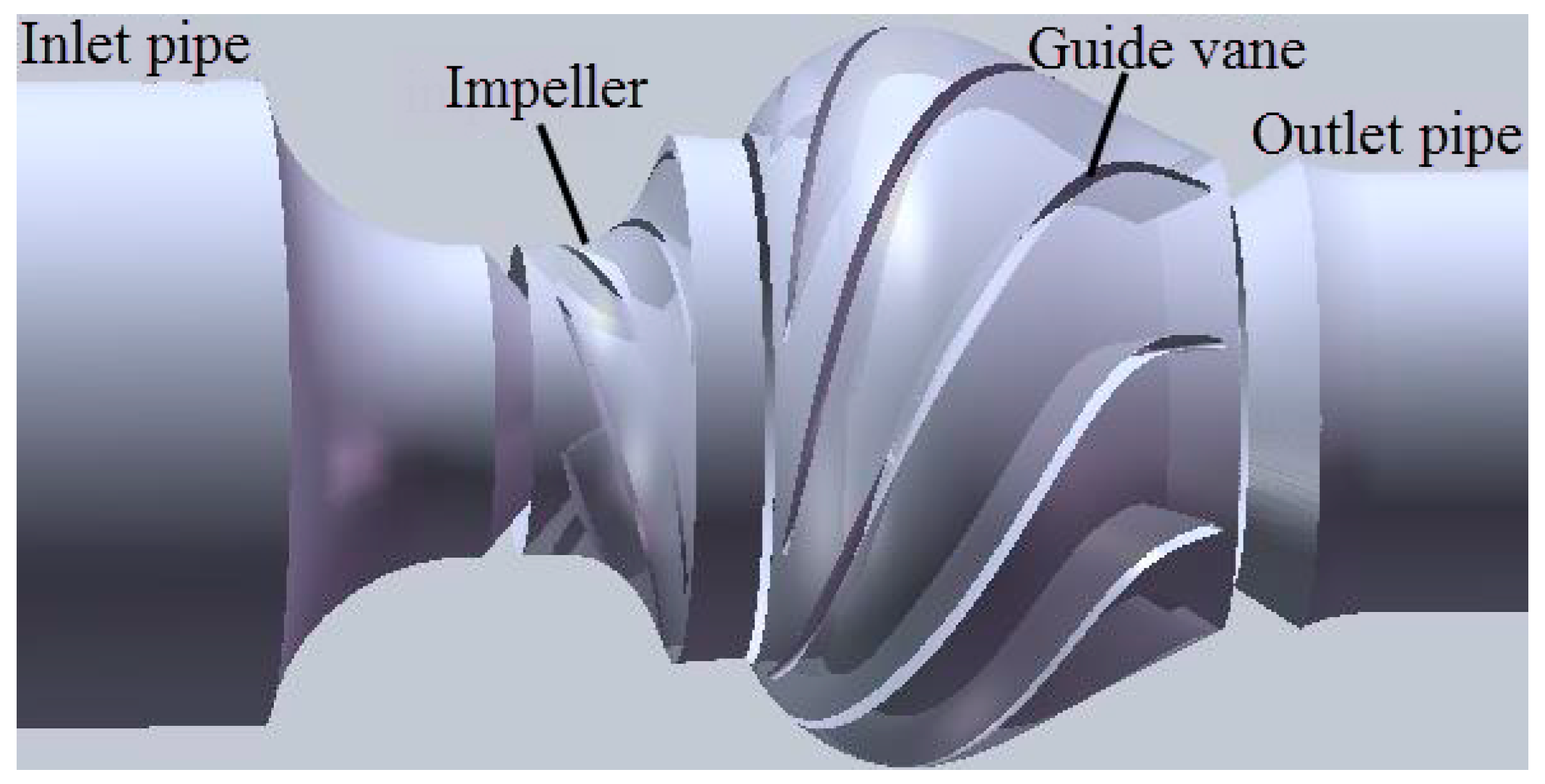

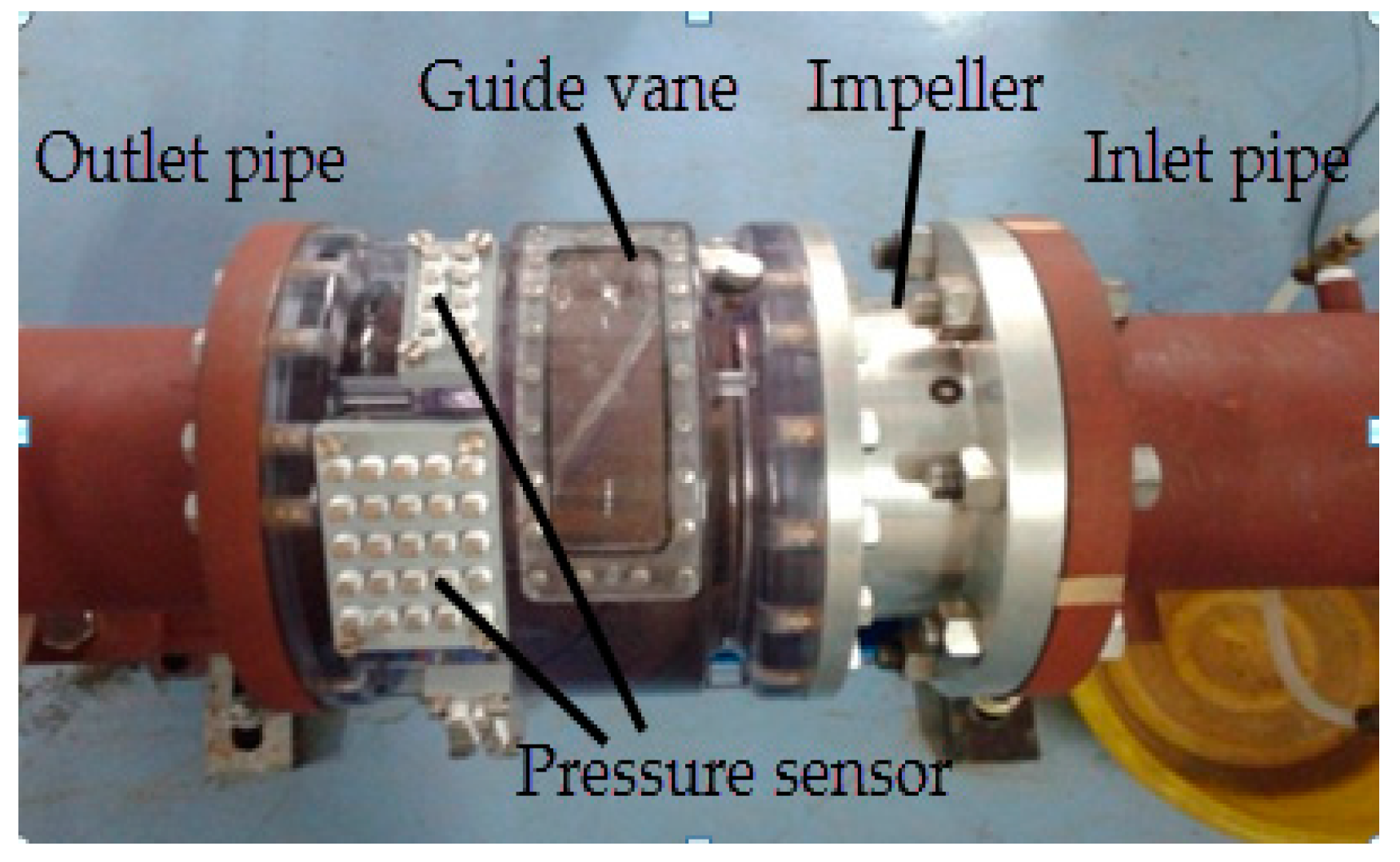
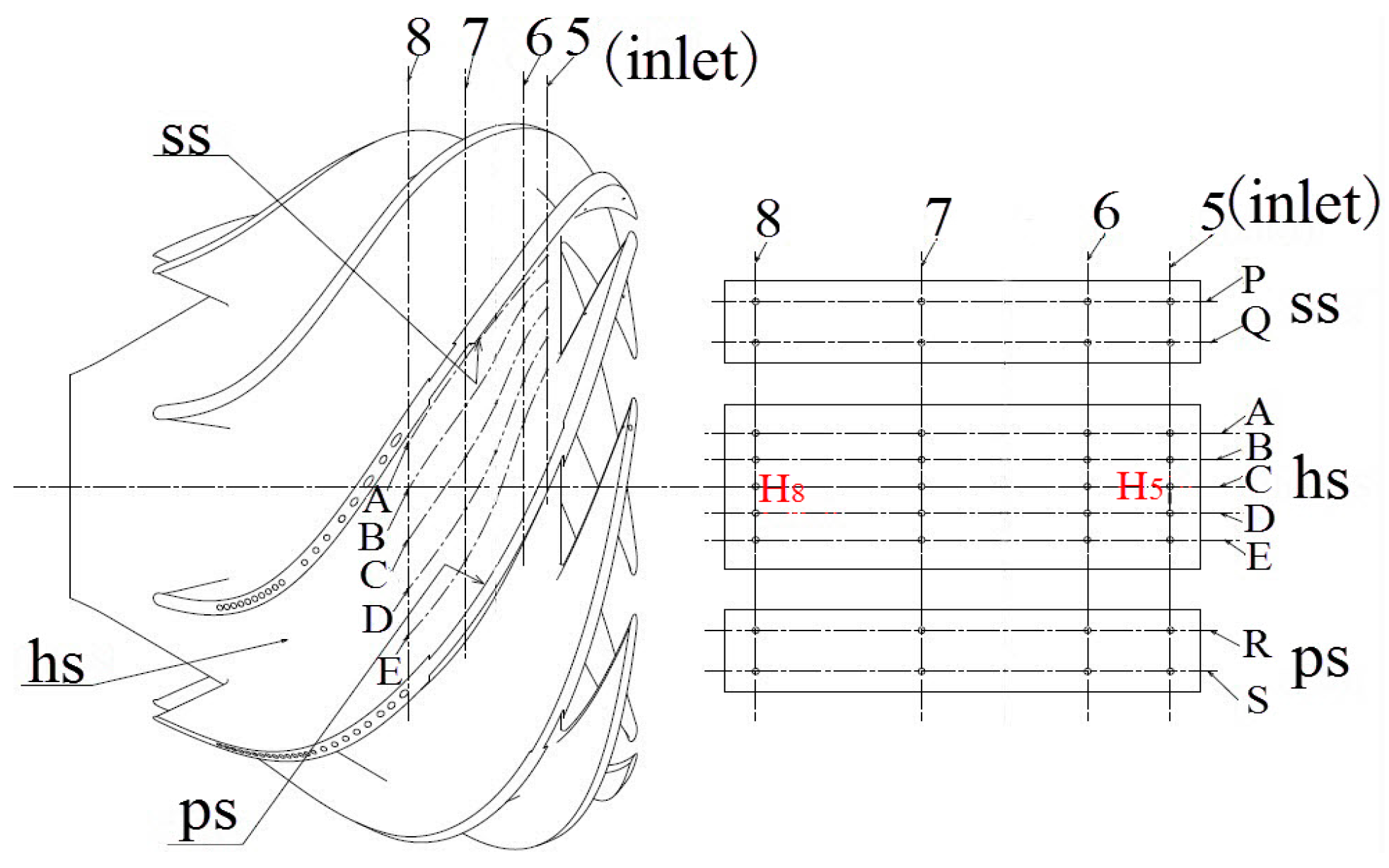
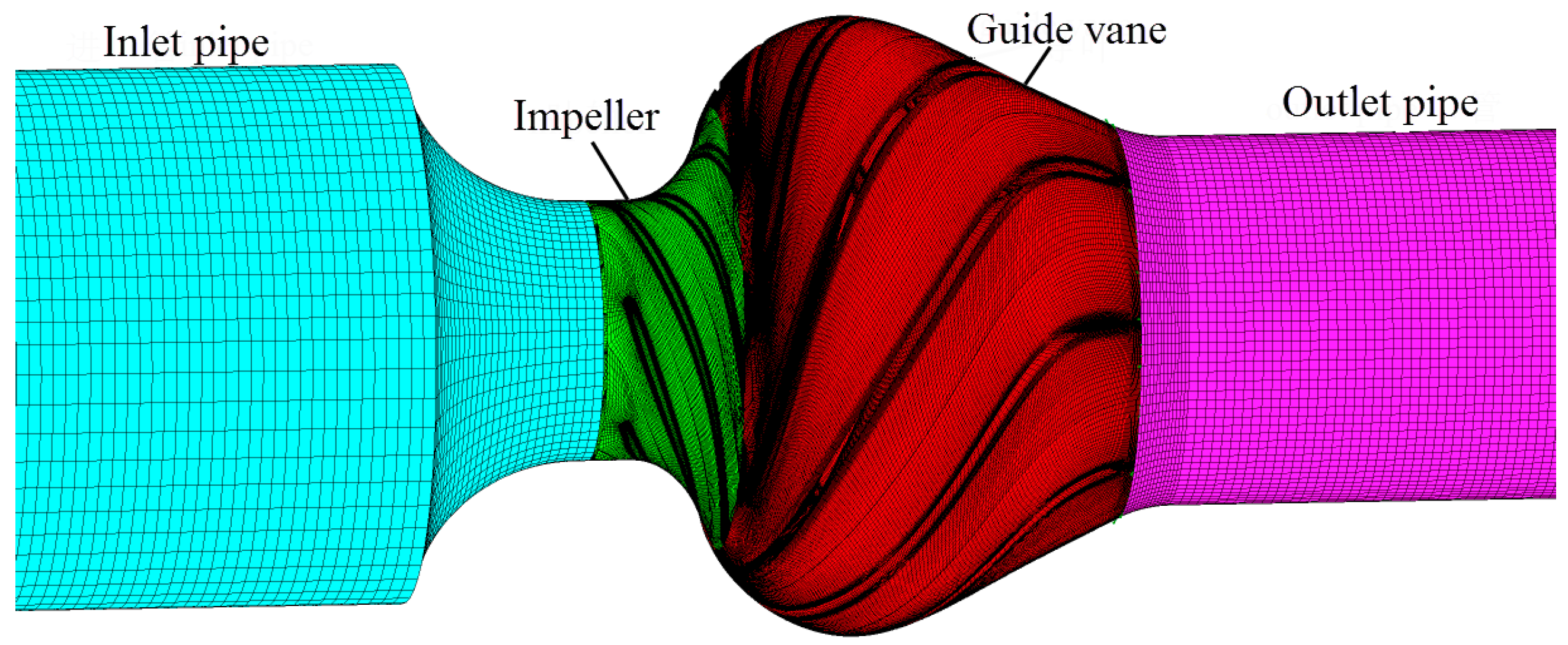

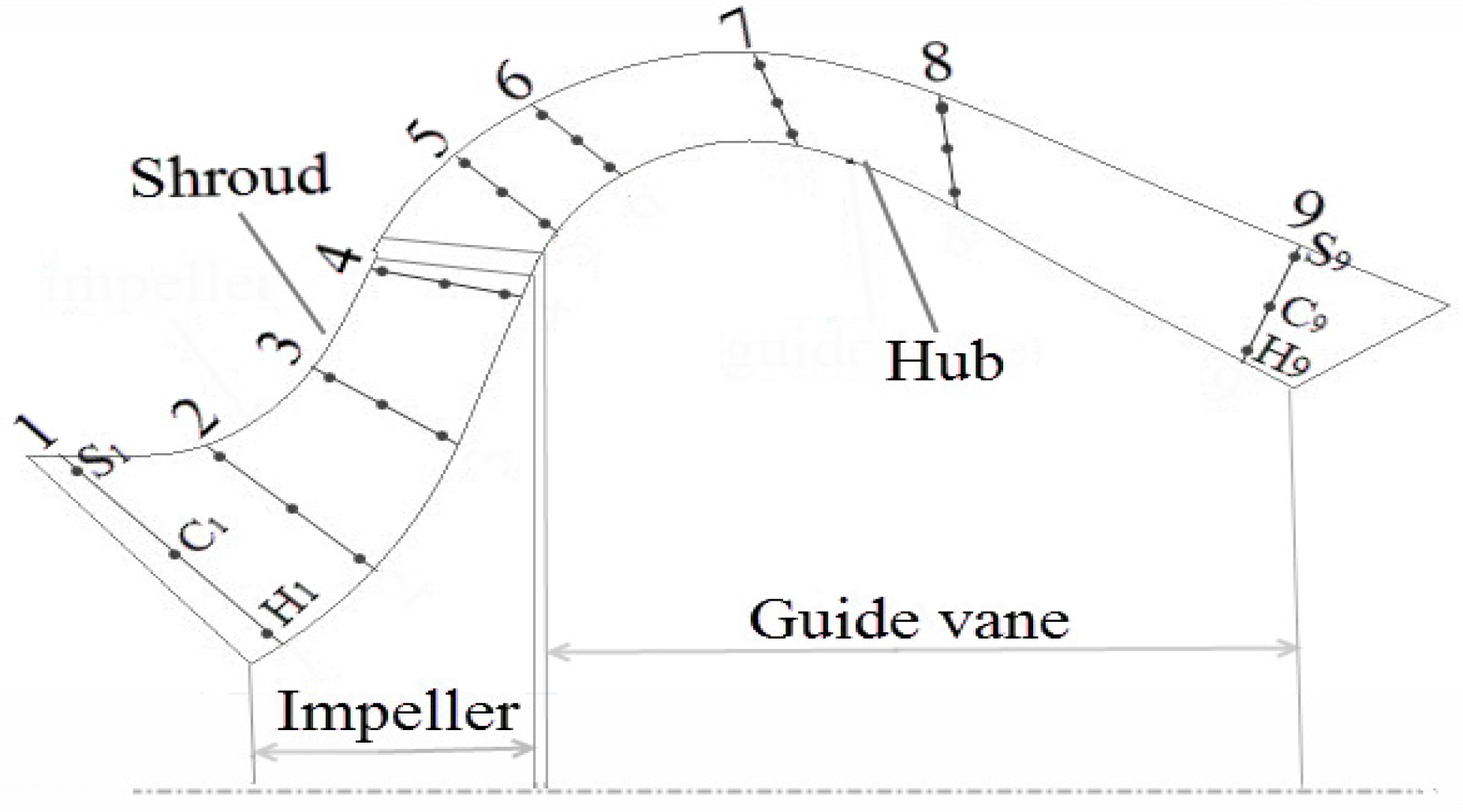
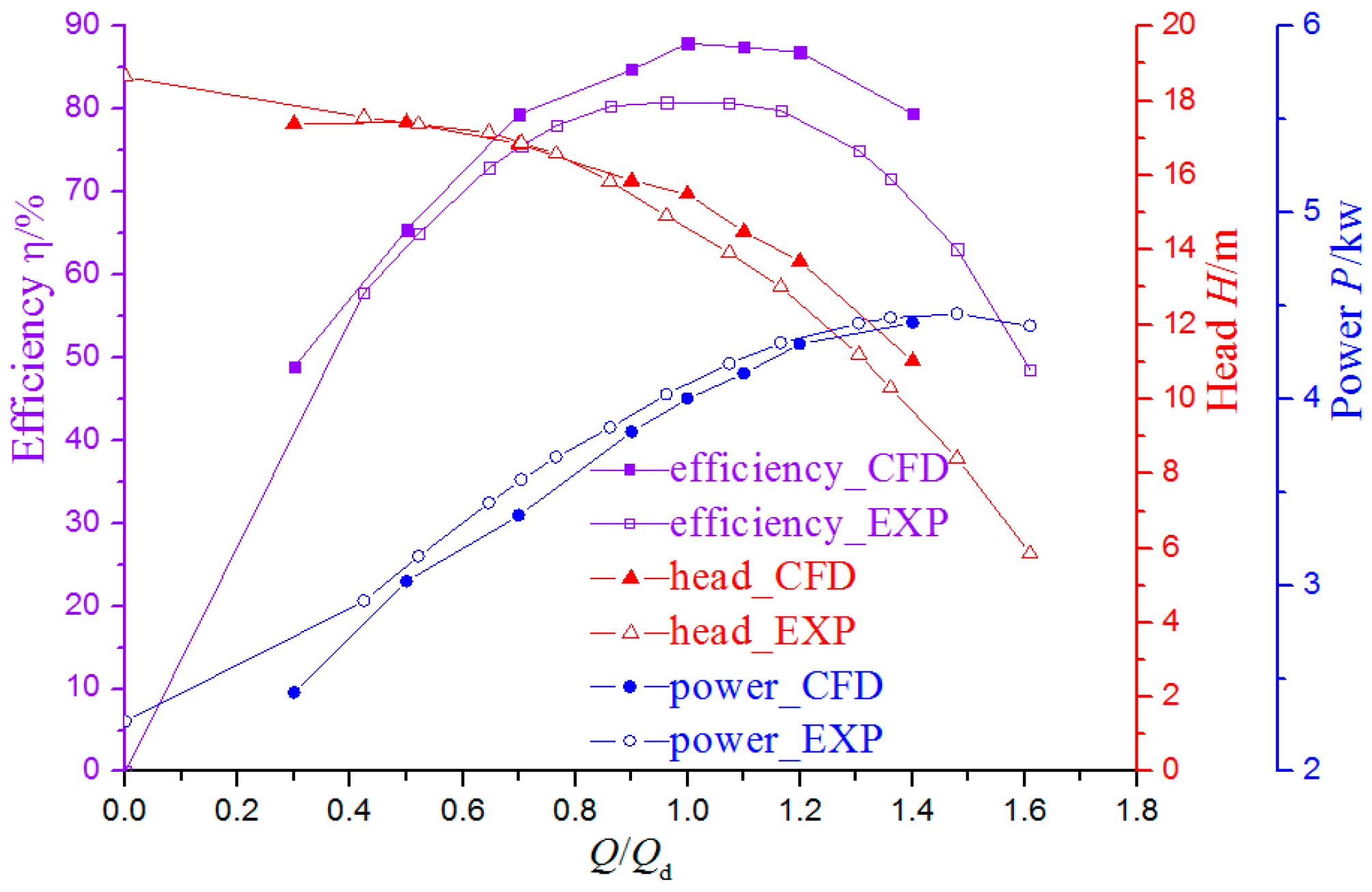
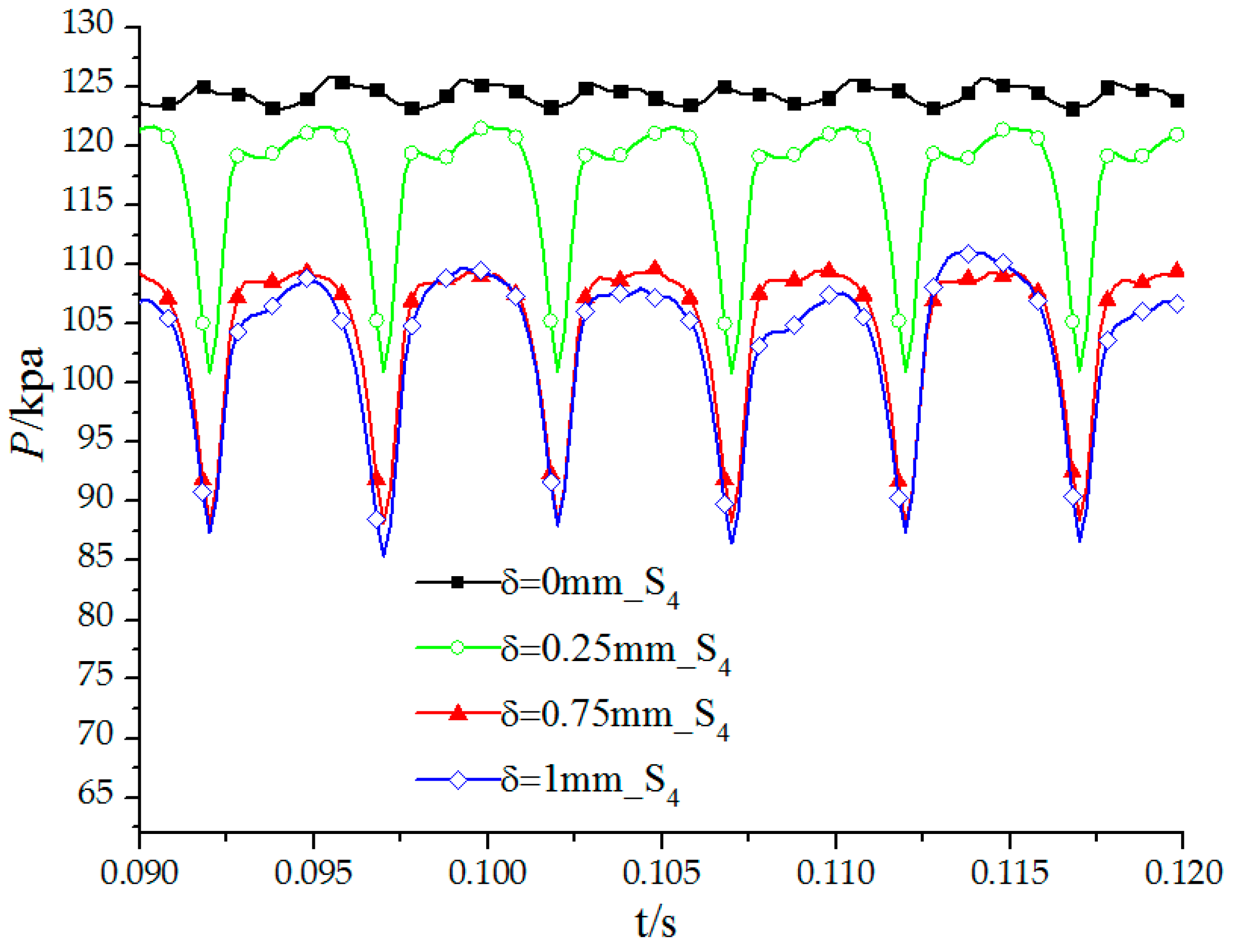
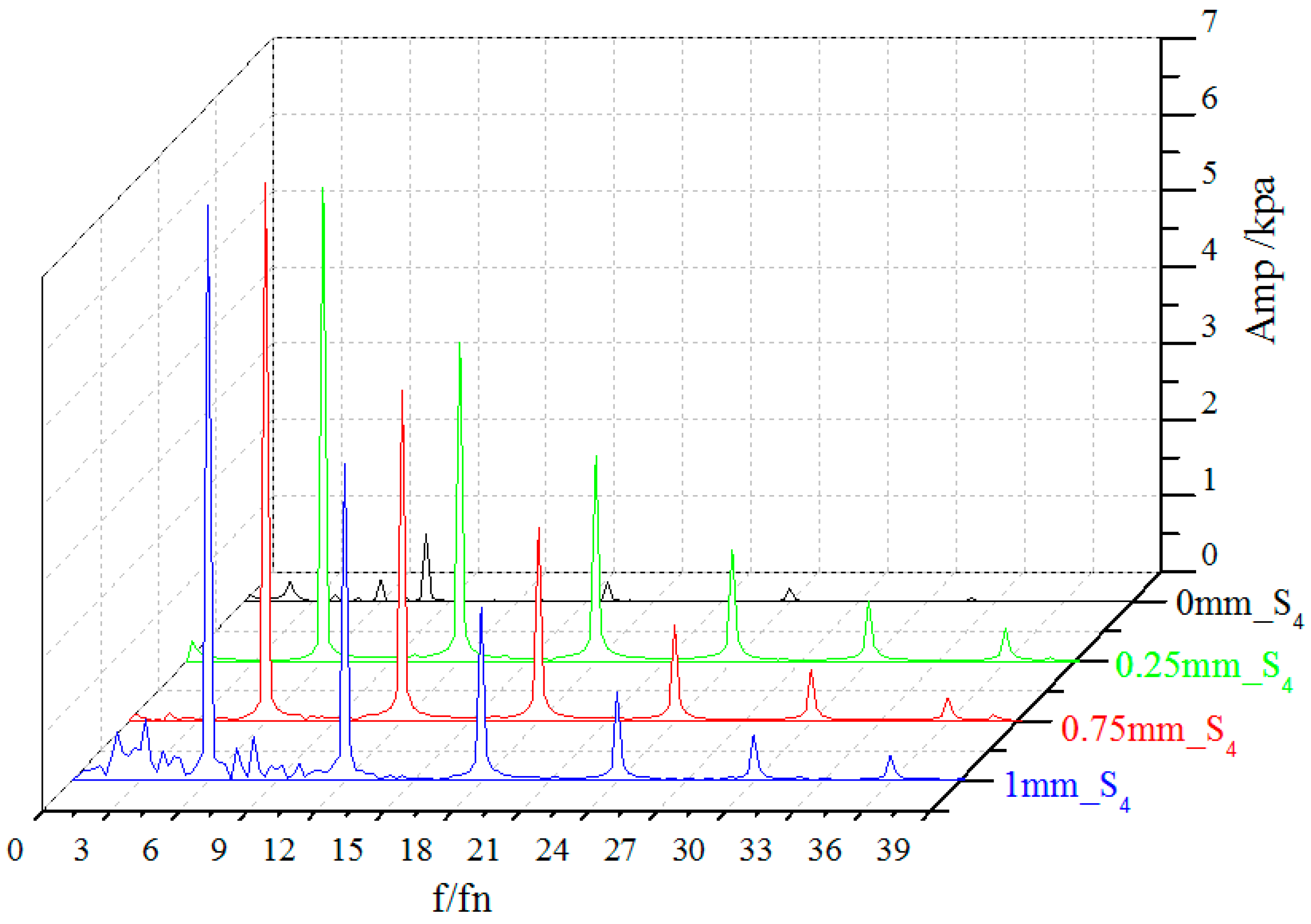
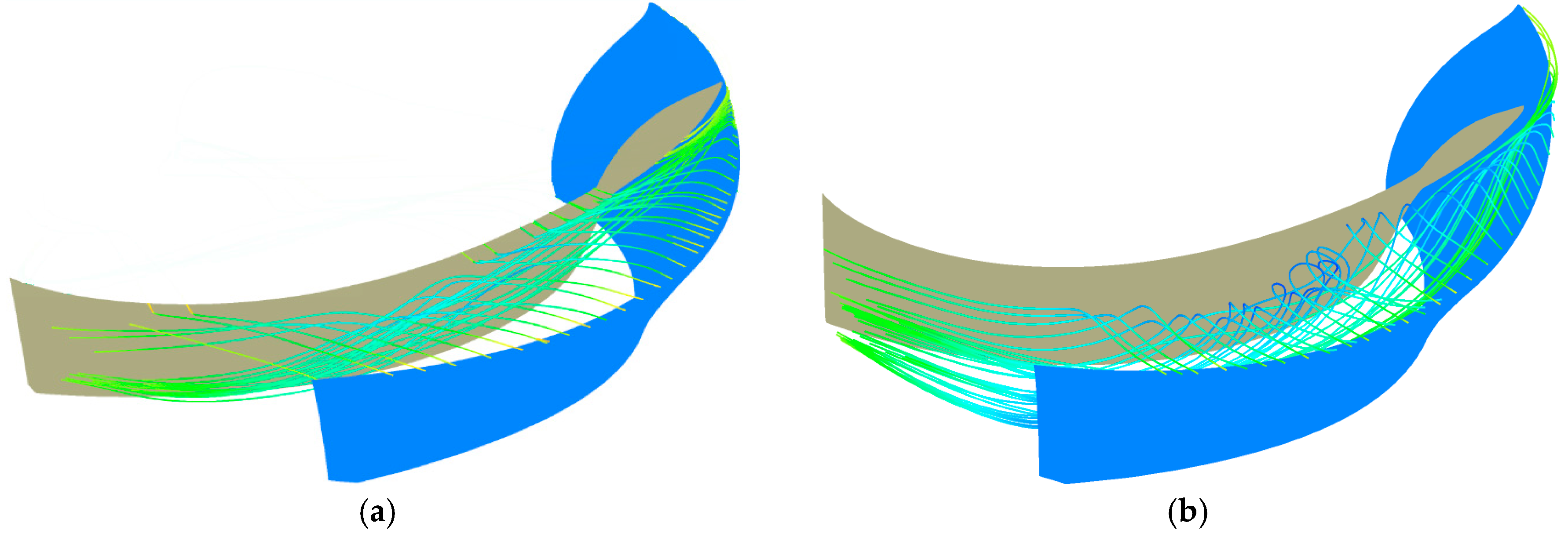
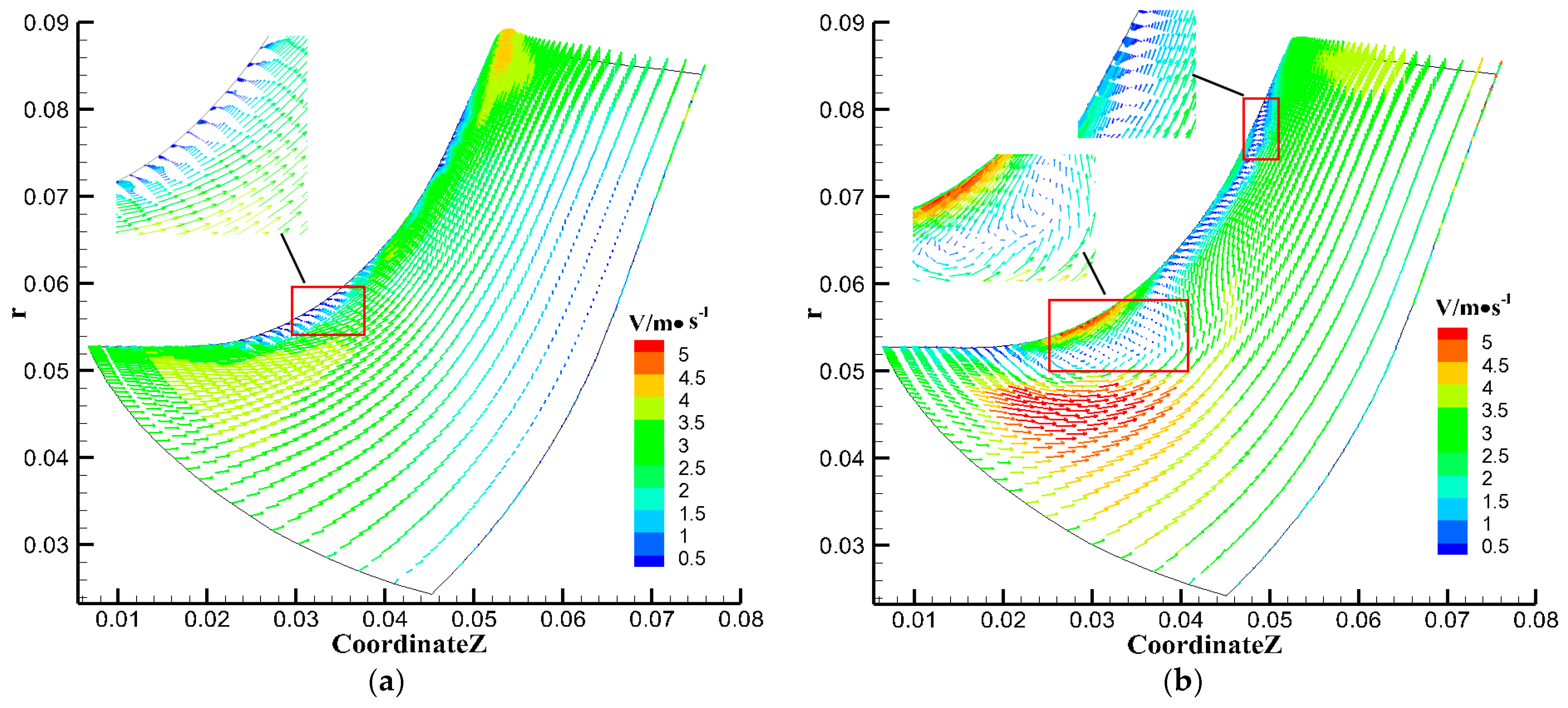
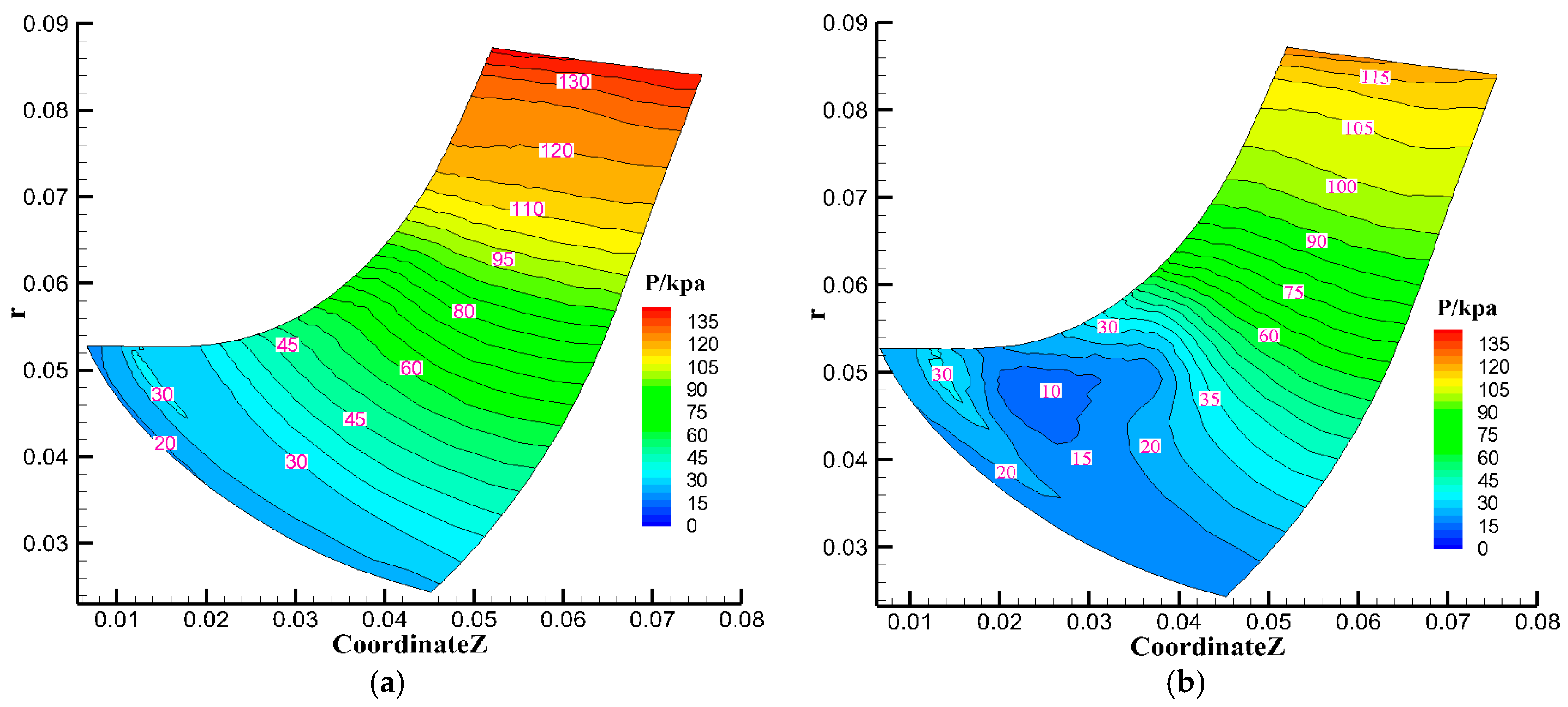

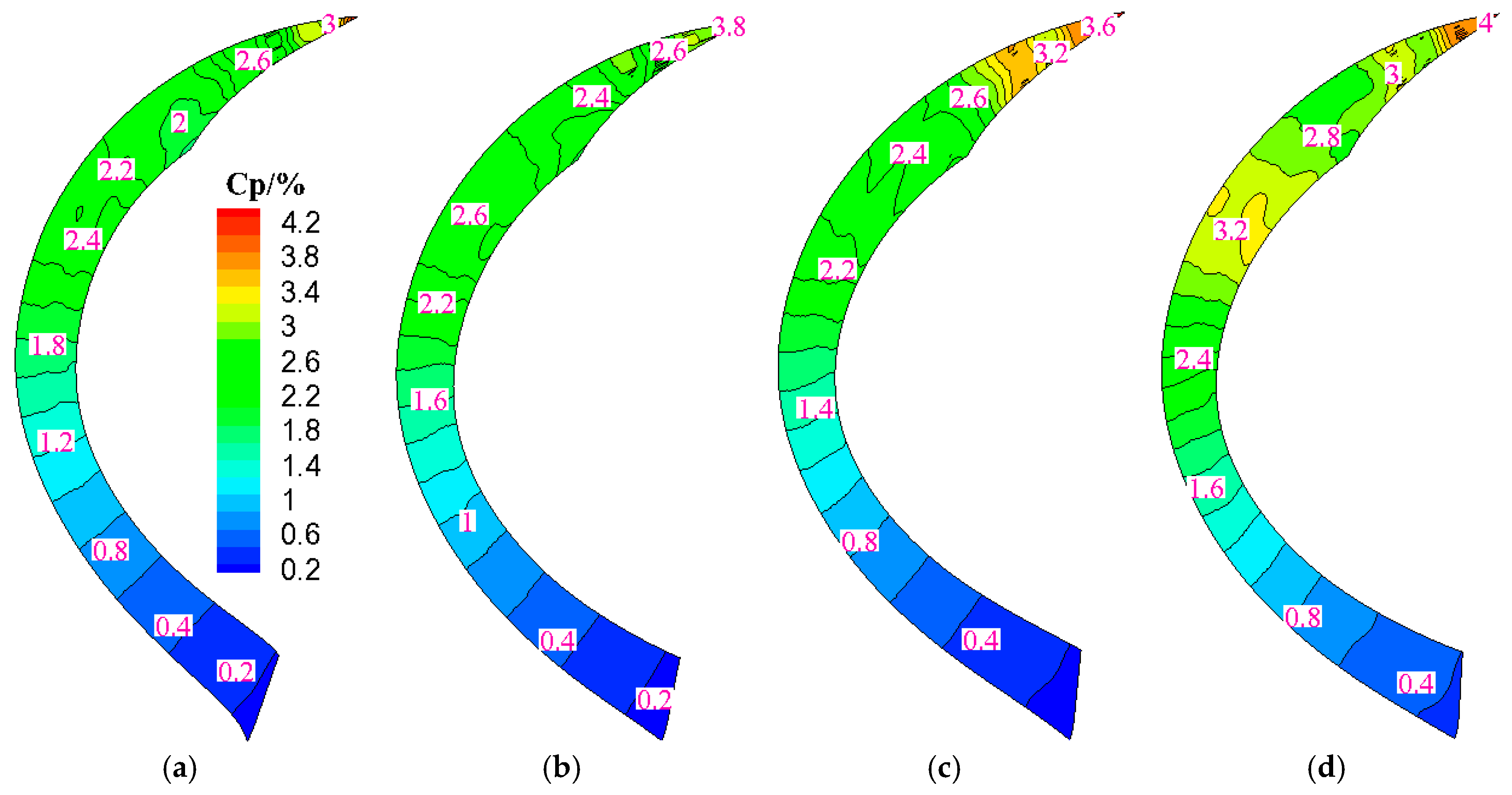
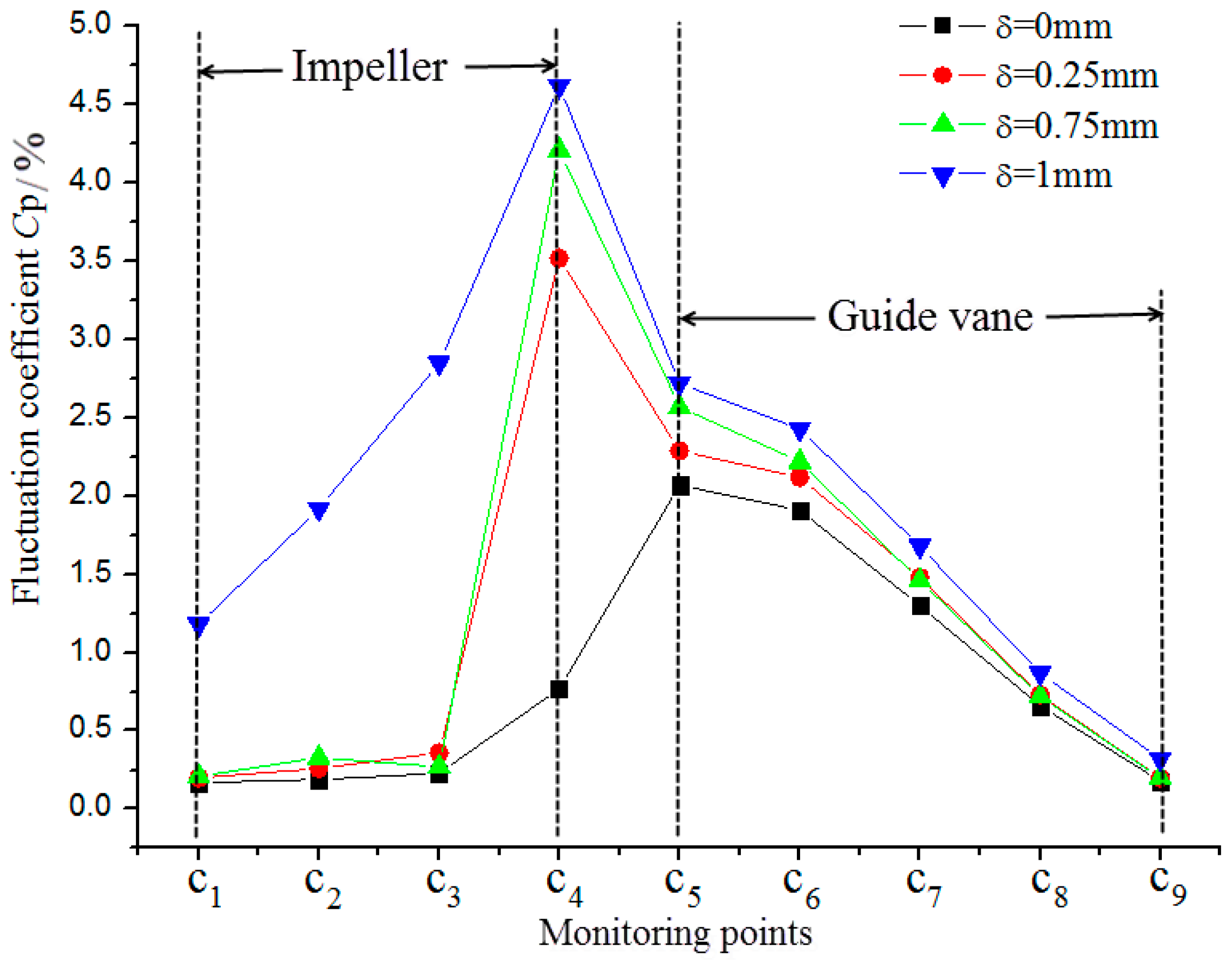


| Conditions | H5 | H6 | H7 | H8 | |||||||||
|---|---|---|---|---|---|---|---|---|---|---|---|---|---|
| n | Q | S | RS | S | RS | S | RS | S | RS | ||||
| r/min | m3/min | kPa | kPa | % | kPa | kPa | % | kPa | kPa | % | kPa | kPa | % |
| 1200 | 0.44 | 89.27 | 3.89 | 4.36 | 141.64 | 2.41 | 1.70 | 148.19 | 1.89 | 1.28 | 152.43 | 1.02 | 0.67 |
| 0.87 | 78.85 | 2.94 | 3.73 | 138.69 | 1.91 | 1.38 | 141.71 | 1.21 | 0.85 | 147.23 | 0.81 | 0.55 | |
| 1500 | 0.55 | 108.73 | 4.65 | 4.28 | 149.91 | 2.54 | 1.69 | 154.40 | 2.02 | 1.31 | 160.31 | 1.78 | 1.11 |
| 1.13 | 92.57 | 4.24 | 4.58 | 144.4 | 2.02 | 1.40 | 148.07 | 1.53 | 1.03 | 155.22 | 1.39 | 0.90 | |
| 1800 | 0.61 | 129.71 | 6.55 | 5.05 | 159.71 | 3.21 | 2.01 | 164.03 | 2.25 | 1.37 | 170.68 | 1.75 | 1.03 |
| 1.2 | 112.98 | 4.59 | 4.06 | 154.55 | 2.11 | 1.37 | 159.19 | 1.88 | 1.18 | 162.8 | 1.66 | 1.02 | |
| 2000 | 0.73 | 144.12 | 9.62 | 6.67 | 167.18 | 5.07 | 3.03 | 172.31 | 2.83 | 1.64 | 173.63 | 2.42 | 1.39 |
| 1.48 | 124.03 | 6.30 | 5.08 | 157.97 | 4.13 | 2.61 | 163.79 | 1.97 | 1.20 | 167.41 | 1.9 | 1.13 | |
| Mesh Information | Inlet Pipe | Impeller | Guide Vane | Outlet Pipe | Total |
|---|---|---|---|---|---|
| Element | 293,930 | 202,720 × 6 | 200,124 × 8 | 513,271 | 3,624,513 |
| Node | 303,552 | 1,311,786 | 1,731,312 | 529,160 | 3,875,810 |
| Parameters | Value |
|---|---|
| Time step | 0.0002 s |
| Total time | 0.3 s |
| Maximum iteration number per time step | 20 |
| Convergence criteria | RMS residual < 1 × 10–4 |
| Advection scheme | High resolution |
| Turbulence numerics | High resolution |
| Transient scheme | Second-order backward Euler |
| Conditions | 0.75Qd | 1Qd | 1.25Qd | |||
|---|---|---|---|---|---|---|
| Clearance δ/mm | Efficiency η/% | Head H/m | Efficiency η/% | Head H/m | Efficiency η/% | Head H/m |
| 0.25 | 77.70 | 16.25 | 84.78 | 14.47 | 82.00 | 11.93 |
| 0.75 | 73.44 | 15.28 | 79.43 | 12.92 | 73.50 | 9.90 |
| 1.00 | 71.64 | 14.65 | 76.54 | 12.04 | 69.70 | 9.03 |
| Points | S1 | S2 | S3 | S4 | |
|---|---|---|---|---|---|
| δ | |||||
| 0 mm | 0.17 | 0.19 | 0.23 | 0.53 | |
| 0.25 mm | 0.21 | 0.26 | 0.35 | 4.08 | |
| 0.75 mm | 0.85 | 0.49 | 0.33 | 4.38 | |
| 1.00 mm | 3.09 | 2.61 | 2.30 | 4.58 | |
| Points | S5 | S6 | S7 | S8 | S9 | |
|---|---|---|---|---|---|---|
| δ | ||||||
| 0 mm | 2.10 | 1.93 | 1.36 | 0.73 | 0.20 | |
| 0.25 mm | 2.34 | 2.13 | 1.54 | 0.82 | 0.21 | |
| 0.75 mm | 2.53 | 2.22 | 1.54 | 0.75 | 0.22 | |
| 1.00 mm | 2.72 | 2.42 | 1.76 | 0.80 | 0.34 | |
© 2017 by the authors. Licensee MDPI, Basel, Switzerland. This article is an open access article distributed under the terms and conditions of the Creative Commons Attribution (CC BY) license ( http://creativecommons.org/licenses/by/4.0/).
Share and Cite
Zhang, W.; Yu, Z.; Zhu, B. Influence of Tip Clearance on Pressure Fluctuation in Low Specific Speed Mixed-Flow Pump Passage. Energies 2017, 10, 148. https://doi.org/10.3390/en10020148
Zhang W, Yu Z, Zhu B. Influence of Tip Clearance on Pressure Fluctuation in Low Specific Speed Mixed-Flow Pump Passage. Energies. 2017; 10(2):148. https://doi.org/10.3390/en10020148
Chicago/Turabian StyleZhang, Wenwu, Zhiyi Yu, and Baoshan Zhu. 2017. "Influence of Tip Clearance on Pressure Fluctuation in Low Specific Speed Mixed-Flow Pump Passage" Energies 10, no. 2: 148. https://doi.org/10.3390/en10020148






